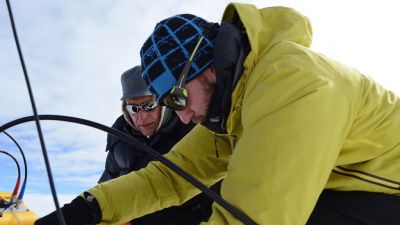
Getting ready for the first field expeditions
"We got treated with warm croissants for breakfast this Sunday. Apart from that, it was nothing like a normal Sunday here at Princess Elisabeth," recounted veteran Belgian reporter Jos van Hemelrijck. Staff members and scientists are working hard to prepare the first field trips of the season.
Logistical work
The departure of the scientific teams heading to the King Baudoin Ice shelf on the coast has been re-scheduled for Wednesday. Between now and then, there's a lot to be done. The mechanics are servicing the Prinoth snow tractors, while our cook, Riet Van de Velde, has been preparing the food rations for the field teams. For two weeks now, he has been cooking food and vacuum sealing it in plastic bags.
Testing and preparing new scientific instruments
ULB glaciologists Frank Pattyn and Brice Van Liefferinge have been testing their new toy, a pRES radar, on the snow behind the ridge. They're expecting this new tool to give them highly detailed information about the layers of ice in the King Baudoin Ice Shelf for their ICECON project. Both had wide grins on their faces after they returned from testing the radar. I think the new equipment passed the test!
Jean-Louis Tison and Morgane Philippe, also working with the ULB ICECON project, have been struggling to assemble their ECLIPS ice core drill, which they plan to use to extract ice cores form the King Baudouin Ice Shelf. They hope to have this complex machine tested by Monday afternoon. The more complex the instrument, the more important it is to do preliminary testing. This baby can take ice cores to a depth of 150 meters!
Meanwhile, the young InBev-Baillet Latour Fellowship laureate who will be accompanying the ICECON scientists to the King Baudouin Ice shelf, Jan Lenaerts, has been assembling an automatic weather station (AWS) for his BENEMELT resarch project. He plans to install the AWS on the ice shelf, where it will transmit data to the University of Utrecht until he returns next season.
A disappointed scientist
Our frenchman Nicolas Bergeot went to the Sør Rodane Mountains to check one of the GPS stations he installed last year. These extremely senstive GPS stations measure tiny variations in the height of the Earth's surface. If the surface of the Earth (basically the bedrock of the continent) rises, it means that the ice sheet is losing mass.
Unfortunately for Nicolas, the harsh winter winds had destroyed the wind turbine providing energy to the battery of his GPS station. When the power was lost, the battery froze, and this means the battery can no longer be recharged. Luckily, he'd installed a number of other GPS stations elsewhere in the field, so overall, his research has not been compromised due to the loss of one GPS station.
Now, if you'd excuse me, I'd better get my gear ready because I am going in the field as well! I'll go to the plateau with Denis Lombardi first and I hope to be able to go to the coast afterwards.
Picture: Frank Pattyn and Brice Van Liefferinge working on their radar machine - © International Polar Foundation / Jos van Hemelrijck
